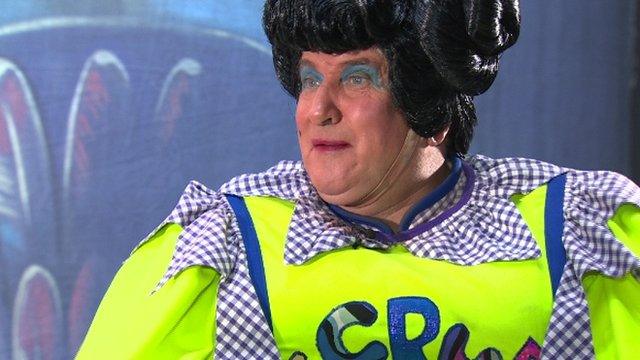Oh yes it is: Why pantomime is such a British affair
- Published

Pantomime attracts plenty of American stars to tread the boards, such as Priscilla Presley who is performing this year in Milton Keynes
The modern pantomime is seen as a quintessentially British affair, baffling visitors to these shores with its eccentric take on fairy tales and vocal audience-participating plots. But is it a genuine British tradition?
Plonk any newcomer to the UK in front of a pantomime and the chances are their face will morph into one of wide-eyed alarm and amused confusion.
A man outlandishly dressed as a hooting technicolour dame? The booming collective audience shout of 'OH NO IT ISN'T!' circling around their ears? The not-so-subtle innuendos peppering a colourful slapstick fairytale?
Our visitors would be forgiven for thinking us all a bit barmy.

The birth of British pantomime used the harlequinade as a starting point, before the Victorians added their own preferences to the art form
And they would be among good company.
Priscilla Presley, who is starring in Aladdin in Milton Keynes this year, described pantomime as a "crazy world".
Even the name "pantomime" produces befuddlement, with Baywatch star Pamela Anderson thinking she would be "miming in a box" when she came over to star in Aladdin in Liverpool.
The theatre tradition has been entertaining millions of Brits for hundreds of years but its humble beginnings in fact lie with a 16th Century Italian theatre form known as Commedia dell'arte.
The slapstick street theatre, which reached England via France, had stock improvised scenarios and stock characters, including an old man Pantalone, a naughty servant Arlecchino, a servant girl Columbine, and a clown or Pierrot character.
In 17th Century England, some of the these characters were adapted into a type of early pantomime called a "harlequinade", most famously featuring the cheeky and acrobatic harlequin.

An early pantomime poster from 1878 still shows the stock harlequinade characters, while nowadays the posters are dominated by celebrities
Originally a comic mime, the harlequinade plot was always about two lovers and a father who is unhappy with the relationship. It was also performed throughout the year, not just at Christmas.
We have the Victorians to thank for the modern British pantomime, says theatre expert Simon Sladen, from the Victoria & Albert Museum.
The British love of dressing up and slapstick humour has transcended time, with cross-dressing characters and an off-beat take on fairy tales.
It was them who introduced the fairytale element and turned the show into two halves, with the harlequinade in the second part.
"The harlequinade fell out of favour because it got a bit boring, but what people liked was the transition from fairytale to harlequinade - a big transformation sequence where the characters from the fairytale were transformed using harlequin's magic bat, which is the magic wand in pantomime today," Mr Sladen said.
Gradually, it was this trickery - the use of trapdoors and shazzam magic - that the British audience wanted to see more of.
But in the age of the Victorian stiff upper lip and British propriety, what was it that led them to embrace this bizarre world so wholeheartedly?
Prof Paul Ward, author of Britishness Since 1870, said beneath the veneer of Victorian "restraint and moderation" there were "elements of eccentricity" in the form of a penchant for fancy dress.
"The British enjoy dressing up," he says.
"Pantomime is part of a continuum with fancy dress balls, popular across the British Empire, amateur dramatics, music hall and cross-dressing, and all sorts of British heroes, real and fictional, dressing as 'the other', such as [explorer] Richard Burton travelling to Mecca in the 1850s dressed as an Arab and Harry Faversham in The Four Feathers dressed as a Sangali native."

English comedian Dan Leno (left) popularised the panto dame in the 1890s, now a staple of modern panto
Added to that, the British were the first to have an industrial working class at which the more over-hammed forms of theatre were aimed.
"In the early part of the 19th Century, theatre was dominated by stage melodrama," said John Storey, emeritus professor of cultural studies at the University of Sunderland.
"These were stories of good versus bad, with the same kind of morality that we find in contemporary soap operas. The audience for these plays was overwhelming working class.
"What was also transferred was audience participation. In pantomime, music hall and stage melodrama there was an expectation that the audience were a part of the entertainment and were actively encouraged to be so."

High profile celebrities have starred in pantomime, ranging from David Hasselhoff in recent years to Cliff Richard and Una Stubbs in the 1960s
The Brits have also long prided themselves in their sense of humour, which Prof Ward says is a "central part" of the national character.
This offbeat comedy, which has spawned the abstract Goon Show and Monty Python, has guaranteed pantomime's perennial place on stage.
But there are more reasons why we love panto as much today as the Victorians did.
The everlasting appeal of gawking at celebrities, for one, has ensured the theatrical form's longevity. No modern pantomime is complete without a celebrity of some sort, but this is not a modern phenomenon.
"We're looking at the late 1870s onwards when suddenly Augustus Harris takes over at the Theatre Royal, Drury Lane and is wanting to produce the biggest spectacles he possibly can to trump everywhere else in the country," Mr Sladen says.
"Although he wasn't the first person to do so, he starts to popularise this notion of employing well-known names - celebrities - to lead the pantomime, to have the pantomime slightly written around them, and for the public to celebrate these figures that they know.
"Now that's not different to today where we've just changed the type of celebrities.
"He was using celebrities from music halls, then we had pop stars, we had soap stars, we've had Hollywood superstars Pamela Anderson and David Hasselhoff come over."
But on the whole panto is the domain of the British celeb.
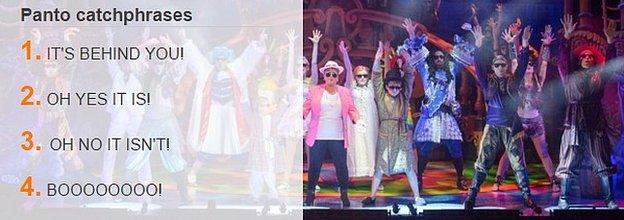
Debbie McGee is starring as a genie in Aladdin at the Regent Theatre in Ipswich this year. She thinks the panto is also kept alive by family tradition.
"I saw my first panto at The Palladium when I was about five-years-old," she says.
"I have loved live theatre in any form ever since. Because we Brits have been brought up with panto and for the majority of people it is a happy memory from childhood, it is a tradition that many families carry on to their own children and grandchildren.
"Audience participation is all part of the fun and slapstick dates back a very long way in the history of British entertainment, even before Laurel and Hardy!"
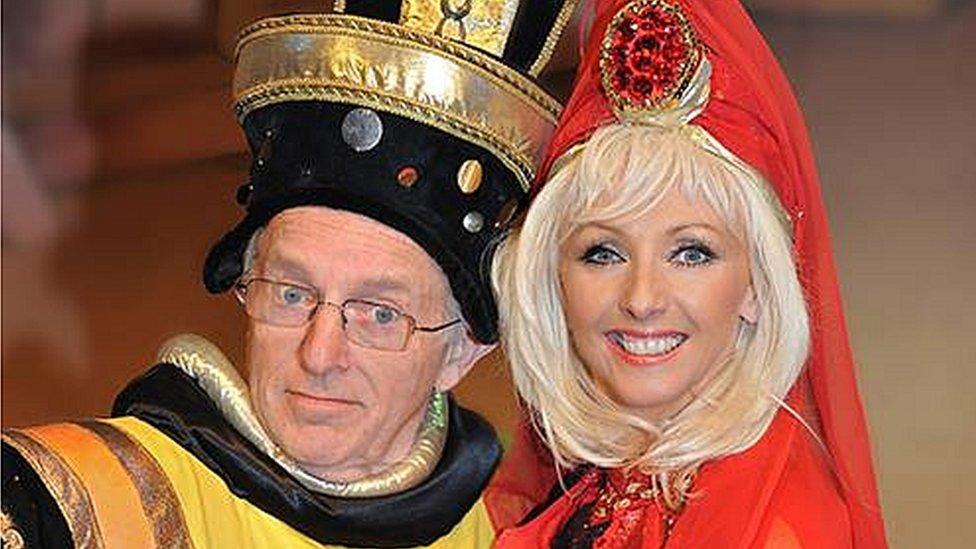
Panto favourite Debbie McGee is starring alongside her husband Paul Daniels in Aladdin in Ipswich this year
For all the talk of pantomime being a British affair, our beloved art form is burrowing its way into other cultures.
Great Britain is now not alone in staging the daringly daft.
"Pantomime has transported itself and translated itself around the world," says Mr Sladen. "Singapore has a panto tradition, South Africa also, and America has had one over the last 10 years.
"They are places really that has either had British rule at some point or in the case of America as a sort of "this is what British people do at Christmas time", so it's being exported as a British product."
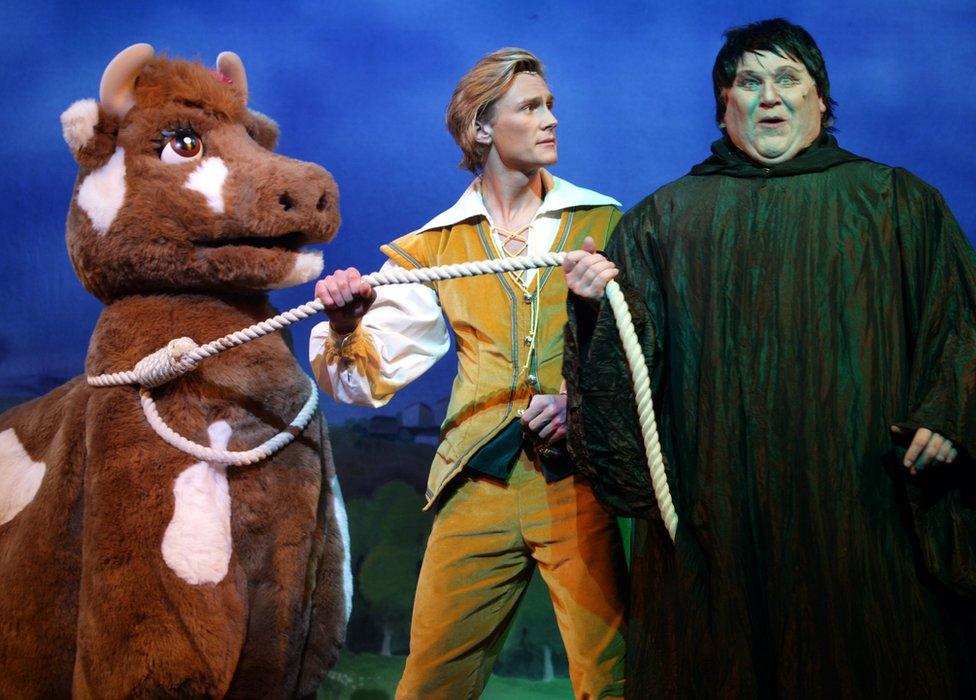
Where else but on a pantomime stage would you see celebrities performing a slapstick fairytale and an actor dressed in a cow costume?
Some countries have, like the Brits did with Commedia, morphed the art form into something individual, so Singapore has staged Jack and the Beansprout, and in Jamaica performers mix panto with the local Anansi stories.
It is the flexibility of the art form that Mr Sladen thinks has helped to keep panto alive.
"Panto is still around today because it embraces everything that's popular," he says.
"That is why pantomime in my opinion will always survive and be celebrated because not only does it reflect the times, it also ensures that what is popular is delivered."
- Published3 January 2016
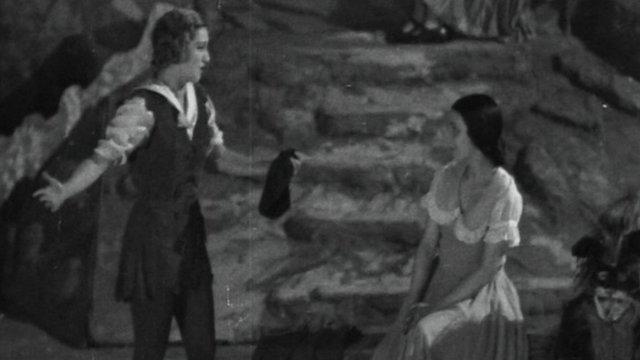
- Published5 December 2015
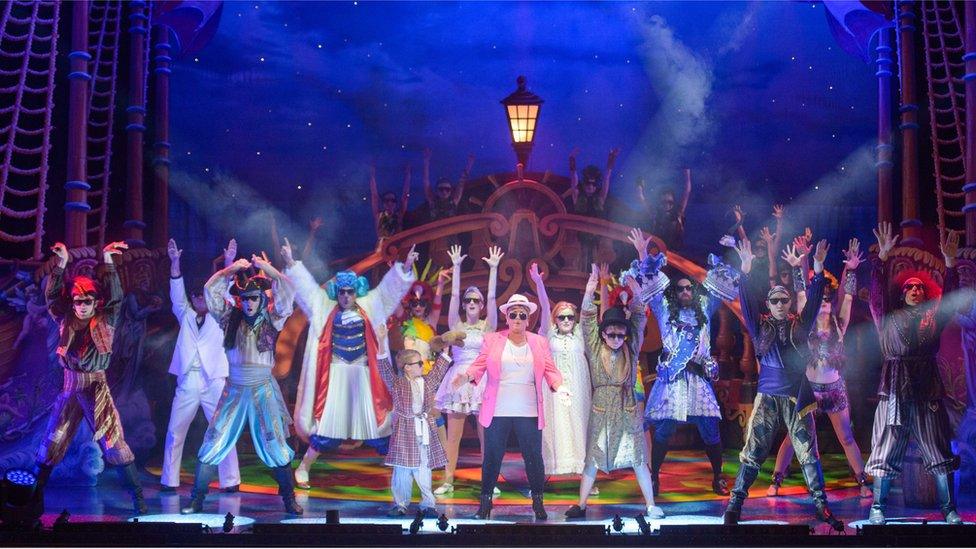
- Published2 November 2015
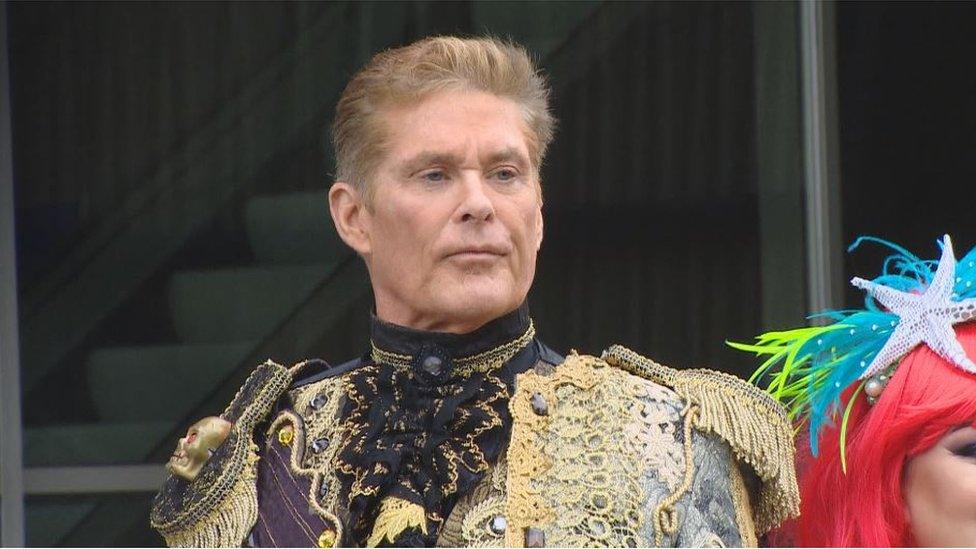
- Published2 January 2015
